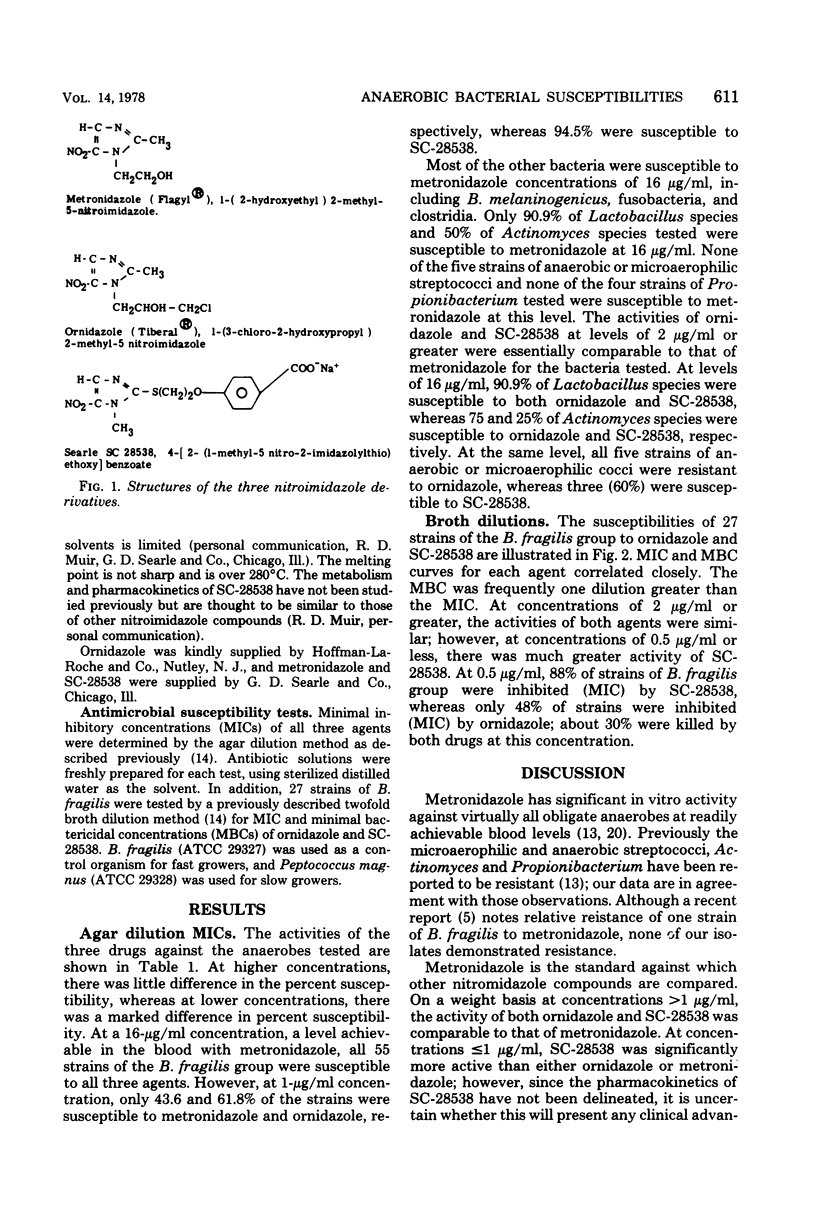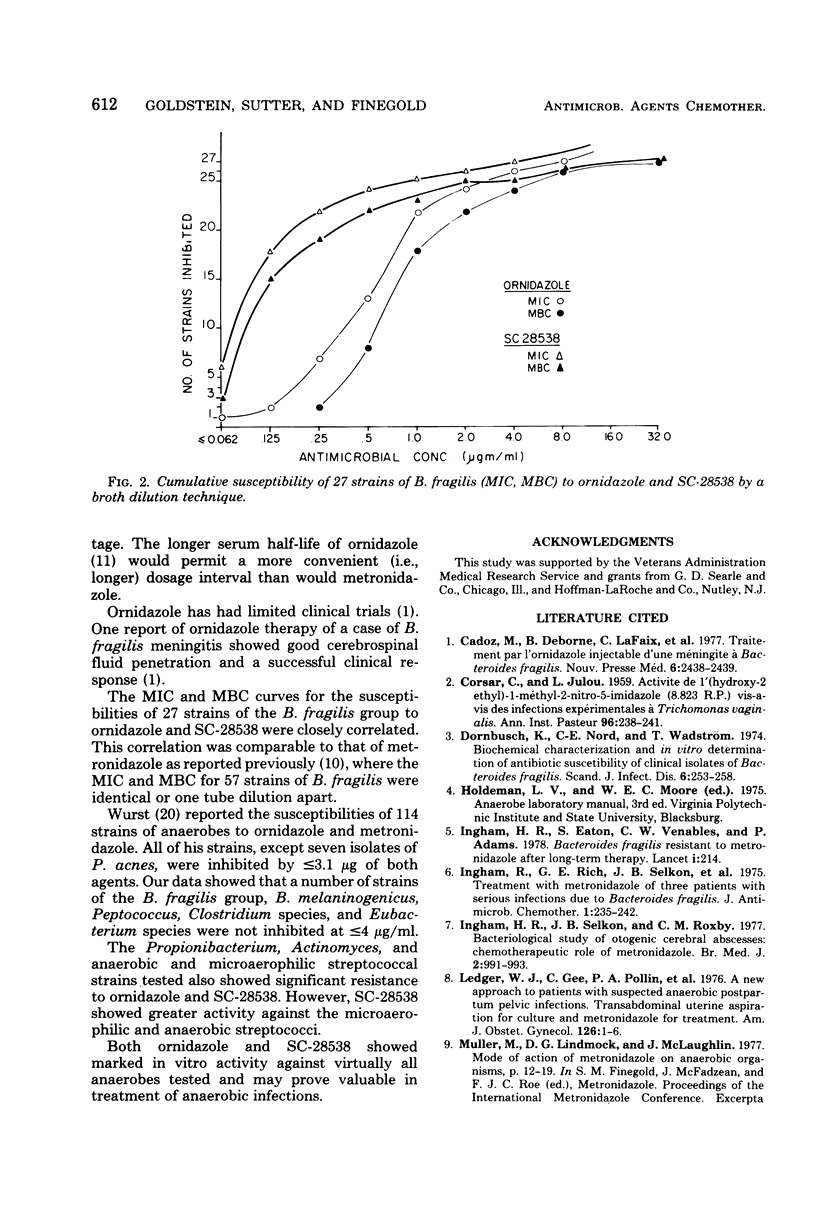Abstract
The susceptibilities of 284 anaerobic bacteria, including 55 strains of the Bacteroides fragilis group, were determined by an agar dilution technique to metronidazole and two newer nitroimidazoles, ornidazole and SC-28538. All three agents showed marked in vitro activity against virtually all anaerobic bacteria tested. At concentrations ≤1 μg/ml, SC-28538 was significantly more active than either metronidazole or ornidazole. At concentrations of >1 μg/ml, the activities of all three agents were comparable. Propionibacterium and Actinomyces showed significant resistance to all three agents. Anaerobic and microaerophilic members of the genus Streptococcus were also often resistant, in contrast to Peptococcus and Peptostreptococcus strains. In addition, the bactericidal activities of ornidazole and SC-28538 were determined against 27 strains of the B. fragilis group by a broth dilution technique. The minimal inhibitory and minimal bactericidal concentrations of each agent were very close. At concentrations of ≤0.5 μg/ml, SC-28538 showed greater bactericidal activity; at concentrations of ≥2 μg/ml, the activies of both agents were similar.
Full text
PDF




Selected References
These references are in PubMed. This may not be the complete list of references from this article.
- COSAR C., JULOU L. Activité de l'(hydroxy-2'éthyl)-1 méthyl-2 nitro-5 imidazole (8.823 R. P.) vis-à-vis des infections expérimentales à Trichomonas vaginalis. Ann Inst Pasteur (Paris) 1959 Feb;96(2):238–241. [PubMed] [Google Scholar]
- Cadoz M., Deborne B., Lafaix C., Langlois-Zantain O., Dublanchet A. Traitement par l'ornidazole injectable d'une méningite à Bacteroïdes fragilis. Nouv Presse Med. 1977 Jul 2;6(27):2438–2439. [PubMed] [Google Scholar]
- Dornbusch K., Nord C. E., Wadström T. Biochemical characterization and in vitro determination of antibiotic susceptibility of clinical isolates of Bacteroides fragilis. Scand J Infect Dis. 1974;6(3):253–258. doi: 10.3109/inf.1974.6.issue-3.08. [DOI] [PubMed] [Google Scholar]
- Ingham H. R., Eaton S., Venables C. W., Adams P. C. Bacteroides fragilis resistant to metronidazole after long-term therapy. Lancet. 1978 Jan 28;1(8057):214–214. doi: 10.1016/s0140-6736(78)90655-4. [DOI] [PubMed] [Google Scholar]
- Ingham H. R., Rich G. E., Selkon J. B., Hale J. H., Roxby C. M., Betty M. J., Johnson R. W., Uldall P. R. Treatment with metronidazole of three patients with serious infections due to Bacteroides fragilis. J Antimicrob Chemother. 1975 Jun;1(2):235–242. doi: 10.1093/jac/1.2.235. [DOI] [PubMed] [Google Scholar]
- Ingham H. R., Slekon J. B., Roxby C. M. Bacteriological study of otogenic cerebral abscesses: chemotherapeutic role of metronidazole. Br Med J. 1977 Oct 15;2(6093):991–993. doi: 10.1136/bmj.2.6093.991. [DOI] [PMC free article] [PubMed] [Google Scholar]
- Ledger W. J., Gee C. L., Pollin P. A., Lewis W. P., Sutter V. L., Finegold S. M. A new approach to patients with suspected anaerobic postpartum pelvic infections. Transabdominal uterine aspiration for culture and metronidazole for treatment. Am J Obstet Gynecol. 1976 Sep 1;126(1):1–6. doi: 10.1016/0002-9378(76)90455-5. [DOI] [PubMed] [Google Scholar]
- Nastro L. J., Finegold S. M. Bactericidal activity of five antimicrobial agents against Bacteroides fragilis. J Infect Dis. 1972 Jul;126(1):104–107. doi: 10.1093/infdis/126.1.104. [DOI] [PubMed] [Google Scholar]
- Schwartz D. E., Jeunet F. Comparative pharmacokinetic studies of ornidazole and metronidazole in man. Chemotherapy. 1976;22(1):19–29. doi: 10.1159/000221906. [DOI] [PubMed] [Google Scholar]
- Sköld M., Gnarpe H., Hillström L. Ornidazole: a new antiprotozoal compound for treatment of Trichomonas vaginalis infection. Br J Vener Dis. 1977 Feb;53(1):44–48. doi: 10.1136/sti.53.1.44. [DOI] [PMC free article] [PubMed] [Google Scholar]
- Sutter V. L., Finegold S. M. Susceptibility of anaerobic bacteria to 23 antimicrobial agents. Antimicrob Agents Chemother. 1976 Oct;10(4):736–752. doi: 10.1128/aac.10.4.736. [DOI] [PMC free article] [PubMed] [Google Scholar]
- Tally F. P., Sutter V. L., Finegold S. M. Metronidazole versus anaerobes. In vitro data and initial clinical observations. Calif Med. 1972 Dec;117(6):22–26. [PMC free article] [PubMed] [Google Scholar]
- Tweit R. C., Kreider E. M., Muir R. D. Synthesis of antimicrobial nitroimidazolyl 2-sulfides, -sulfoxides, and -sulfones. J Med Chem. 1973 Oct;16(10):1161–1169. doi: 10.1021/jm00268a021. [DOI] [PubMed] [Google Scholar]
- Tweit R. C., Muir R. D., Ziecina S. Nitroimidazoles with antibacterial activity against Neisseria gonorrhoeae. J Med Chem. 1977 Dec;20(12):1697–1700. doi: 10.1021/jm00222a036. [DOI] [PubMed] [Google Scholar]
- Wust J. Susceptibility of anaerobic bacteria to metronidazole, ornidazole, and tinidazole and routine susceptibility testing by standardized methods. Antimicrob Agents Chemother. 1977 Apr;11(4):631–637. doi: 10.1128/aac.11.4.631. [DOI] [PMC free article] [PubMed] [Google Scholar]


